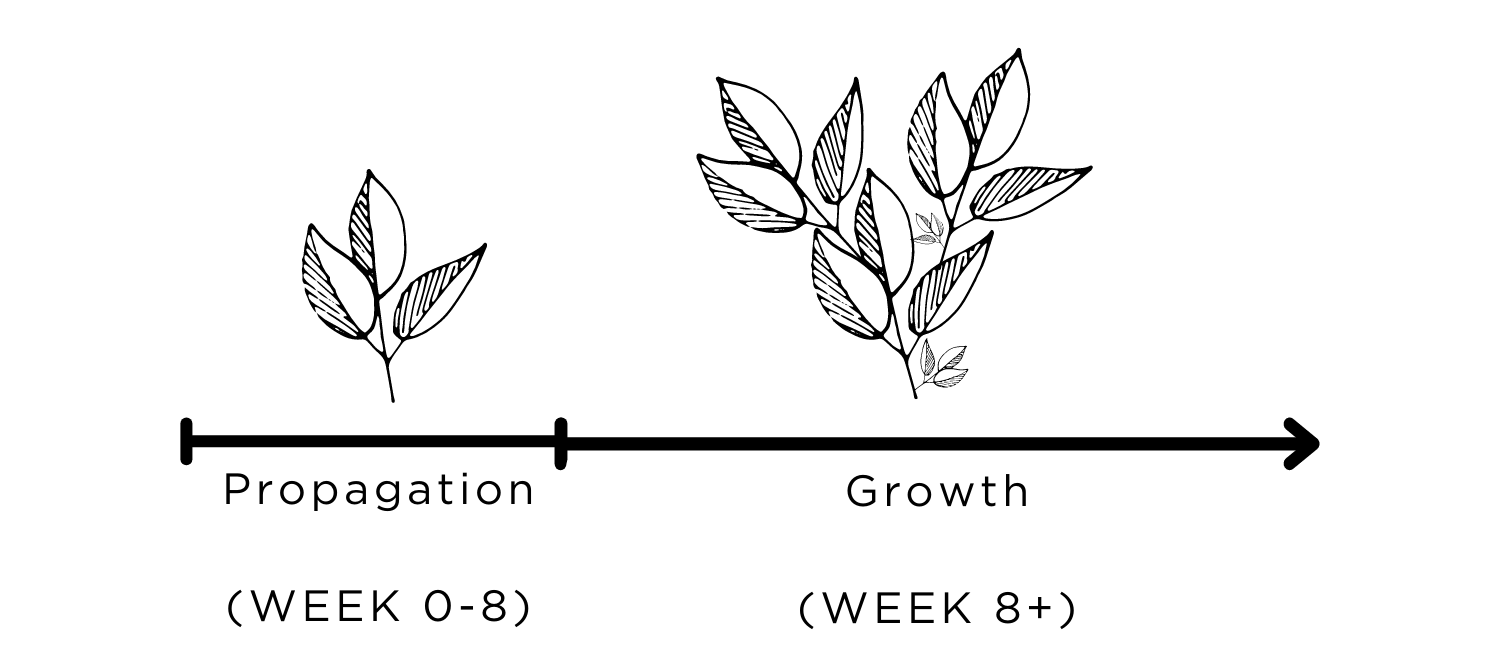When most people think about plants in water, it's usually about water propagation. And that makes sense. It's a beautiful and easy way to turn a single plant into multiple flourishing new plants. A method that works great for most house plants.
But water as a medium can be so much more than that for the right plants. It can be the actual medium that gives them life and allows them to grow.
It's easy to bundle plants growing in water into the bucket that is 'propagation' because that's where the process generally starts. But talk to any tenured plant parent, and they're sure to have stories of cuttings left in water to propagate that were forgotten and continued to grow for long periods of time. We like to draw a distinction at some point in that process and help bring a bit more clarity on the difference between propagation in water and growing plants in water.
Let's get started with some definitions.
Propagation is the process of cloning a plant. Effectively taking a single plant and turning it into multiple genetic duplicates of itself.
As sciency as that sounds - and it is very sciency - it's actually quite simple to do, especially in water. Special parts of most plants are programmed to grow new roots when exposed to the right environmental factors. One of those factors is being submerged in water.
It's common to propagate plants with the intent of replanting the propagation in soil or other mediums once a healthy root system has developed. It usually takes 1-8 weeks for roots to show up. The biggest determinant of time is the plant, followed by lighting, temperature, and humidity.
But what happens when a plant stays after propagation has taken place?
Plants successfully propagated in water have grown roots which support the plant's growth. Things like water, nutrients, and oxygen - all components of healthy plant growth - are accessible to the plant in this submerged state.
If you're someone who's experienced overwatering a plant before, this could seem strange to you. And you'd be right. The roots that grow in water are different from what a plant will grow in soil. Specifically, they're more adept at utilizing the oxygen that exist in water than soil grown plants which utilize oxygen between the soil.
If you were to dig up a plant grown in soil, wash off its roots, and drop it in water, more often than not that plant would drown from lack of oxygen. Some, lucky ones, would hold out long enough to grow new roots, which then could support the plants growth and transition to water. The bigger the plant, the harder this transition often is.
Armed with this new information, growing plants in water is literally that. Rather than transferring a propagation into your soil medium, you instead nurture the plant in water and promote further root and leaf growth through nutrients, fresh water, and appropriate lighting.

There's no specific time or threshold that dictates a plant going from one state to the next. But plants do transition from one stage to the next and after a certain point, there's no going back.
How we like to think about is that plants commit resources to growing roots, similar to shooting off new leaves. Since the roots are adept at either growing in soil or growing in water, if they've stayed in water too long, it can make it harder for the plant to commit further resources to transitioning it's root system over to the new medium. In better cases this can mean a bit of root rot and a slower transition. In worse situations, the plant simply dies.
Fortunately, we're talking large windows for most plants. You can expect a plant to propagate in a few weeks in most cases, at which point root systems begin to develop. It's fair to say that there is about a 2 month window to easily transition most propagations into other mediums once propagation has happened, after which that window begins to close.
Additionally, really anytime after those new roots have been established with that plant remaining in water, it is growing in water. Congratulations!
Nutrients aren’t necessary to the propagation process. Plants could benefit more from rooting hormones or other root stimulants instead. However, liquid nutrients are super helpful when growing plants in water. They give additional support to the plant as it’s developing new, healthy leaves or roots.
Finding the right nutrients is a topic of its own, but we'd recommend finding a nutrient solution intended for hydroponic growth. We have a great nutrient solution to support plant health in our shop that you can check out here.
Growing plants need plenty of oxygen to their roots. In commercial hydroponic systems this often comes in the way of pumping air into the water systems through air stones. Fortunately, most water has oxygen trapped amidst its water molecules which means simply replacing water for your plant every few weeks does an amazing job of providing a constant supply of fresh oxygen to use for growth.
For plants to photosynthesize, light is required. And that's no different for plants in water.
We recommend finding medium to low indirect light for most houseplants in water. This eliminates or slows potential algae growth in the water, while allowing your plant to grow new leaves and healthy root systems
Understanding the lifecycle of propagations to growing in water is a really helpful framework to anyone looking to adorn their home with beautiful, healthy plants.
Plants in water offer less mess than soil mediums, don't require special watering schedules, and are exceptionally difficult to kill. Even for the worst plant people.
If you'd like to share your growing-in-water plant journey with other plant lovers, we encourage you to join our Facebook Community where we share tips, tricks, and inspiration.